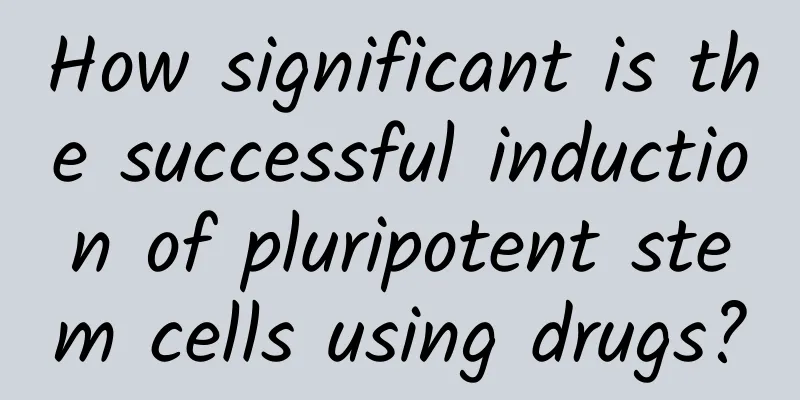How significant is the successful induction of pluripotent stem cells using drugs?

|
Recently, Ding Sheng, Liu Kang and Ma Tianhua from Tsinghua University published a research paper titled "Induction of mouse totipotent stem cells by a defined chemical cocktail" online in Nature as co-corresponding authors. The study showed that a combination of three small molecules, TTNPB, 1-Azakenpaulllone and WS6, can induce mouse pluripotent stem cells (PSCs) into totipotent stem cells (TotiSCs) with the potential to transform into complete organisms, and that the totipotency of these induced cells (intra-embryonic and extra-embryonic differentiation potential) can be maintained in the laboratory. If this is proven to be true, it will be a major breakthrough in human history. While sharing this good news, let's talk about this experiment from five aspects today! 1. Background of this study 2. What is this study? 3. This study is similar to the previous Nature study by the Chinese Academy of Sciences/HuaDa 4. Why wait? 5. If the proof is true, what is the significance? 01. Background of the Study Before we begin, let’s talk about the background Everyone should be familiar with stem cells, which are able to differentiate, or in layman's terms, become various types of cells. Of course, according to stemness, they can be divided into many categories. For example, the most stem-like totipotent stem cells can differentiate into all cell types. Multipotent stem cells can differentiate into a series of cell types. Of course, there are also specialized stem cells, such as our hematopoietic stem cells. In theory, the most perfect stem cell is our fertilized egg. We humans start from a fertilized egg and eventually become a complete individual. However, there is a problem with stem cells. In reality, they face the biggest challenge: time. As time goes by, human stem cells gradually differentiate and lose their stemness. For example, in the blastocyst stage, there are many cells with strong stemness. By the time of birth, only some pluripotent stem cells are left, and totipotent stem cells are generally considered to be gone. By the time we become adults, only a very small number of specialized stem cells remain, such as hematopoietic stem cells. So for an adult, if you want to find pluripotent or totipotent stem cells, there is no way. So, when we are in trouble, we have to think of change. So, can we create stem cells artificially? This leads to one of the hottest areas in the field of stem cells today: artificially induced pluripotent stem cells. In 2006, Shinya Yamanaka was the first to publish a study in Cell, inducing stem cells from mature somatic cells for the first time. This is the famous artificially induced stem cells, and he won the 2012 Nobel Prize for this, almost breaking the record of the Nobel Prize in Physiology or Medicine. After all, the verification cycle of this award is very long. Shinya Yamanaka used four factors, namely Oct3/4, Sox2, Klf4 and c-Myc, which are called Yamanaka factors, and then used viral vectors to introduce the four transcription factors into cells. However, there are some problems with these factors. Among them are the cancer factor c-myc, the transcription factor KLF4, and the use of viral vectors. It can be said that "five poisons are all there". Although it is later believed that the risk is average, it should be known that in clinical applications, these factors are more or less like time bombs. Who knows if these cells are transplanted one day and cancer is caused? What's the point? Therefore, in recent years, a branch of the stem cell field has been to verify the risks of these factors and to find new factors. For example, in 2017, a paper in Science found that early miRNAs could expand the potential of embryonic stem cells. Thus, a new branch emerged: since biological factors are too risky, can chemical factors be used? Chemical factors have many advantages. For example, they are simple, clear, and easy to study. Moreover, chemical factors are more durable in practice than biological factors (think about it, biological drugs have many conditions, and injecting insulin requires a refrigerator and certain methods, and has a short shelf life, while drugs like metformin are long-lasting). The operation is simple, the time and space are easy to control, the effect is reversible, and it can avoid the problems of genetic manipulation. This is a hot field: chemical reprogramming. 02. What is this research? As we said above, since there are many problems with biological factors, it would be better to find chemical factors. This is how the research of this article came about. The method is similar to that of Shinya Yamanaka at that time, that is, screening. Initially, they found more than 3,000 small molecule drug combinations, and then screened them in rounds (it was not easy). Finally, they found such a combination. There are three small molecules in total, namely: TTNPB, 86 1-Azakenpaullone, WS6. They took one of the first letters of each to form the combination name TAW. Take a look at the effect of this TAW: The next step is to verify whether these factors are effective. They call the stem cells induced by chemical factors chemically induced totipotent stem cells (ciTotiSCs). As shown in the picture above (actually you don’t need to look at it, it’s too complicated). In short, the conclusion is: this strategy is really feasible! However, since they claim to have achieved pluripotent stem cells, then of course we have to compare them. So, the next step is to use a series of methods to compare and see if they are really pluripotent stem cells. The objects of comparison are ciTotiSCs, mESC (mouse embryonic stem cells) and embryo (embryo) they created. The conclusion is that, in general, ciTotiSCs are very close to totipotent stem cells. (In addition, the development process of the fertilized egg will go through zygote activation, 2-4-8 to blastocyst, etc. We generally believe that before zygote activation, it is actually a mixture of sperm and egg, unlike stem cells) In fact, they conducted studies at the transcriptome, epigenome and metabolome levels, which are basically the most stringent standards in omics, and found that hundreds of key genes can be turned on in ciTotiSCs, and the overall pattern is close to that of pluripotent stem cells. Some genes related to pluripotent stem cells are silent in TAW cells. Is it really omnipotent? Since it claims to be omnipotent, let’s do an animal experiment. Next, we conducted some developmental experiments to see how omnipotent these so-called omnipotent stem cells are. They injected these cells into early mouse embryos to observe their differentiation potential in vivo. As shown in the figure above, it was found that these cells have the characteristics of totipotent stem cells, and can differentiate into intraembryonic and extraembryonic lineages in mice, and have the ability to develop into a fetus and placenta (placenta is very important. One of the biggest problems of iPSCs at present is that they cannot develop into a placenta, so it is naturally impossible to start a life from scratch) So, this is probably the content of the entire paper, that is, using chemical factors to achieve the induction of pluripotent stem cells. 03. What is the difference between this research and the previous Nature study by the Chinese Academy of Sciences/BGI? Many people may think of another study, which was jointly published in Nature by the Chinese Academy of Sciences and Shenzhen BGI Life Sciences in March this year. They used somatic cell induction to cultivate human pluripotent stem cells that were similar to the 3-day development state of a fertilized egg. Overall, the two studies have in common that they both conducted research on artificially induced pluripotent stem cells and both achieved totipotent stem cells. The difference is: 1. Different starting points The previous article started with induction from somatic cells, while this article from Tsinghua University started with induction from mouse embryonic stem cells. 2. Different endpoints The previous article believed that the induced stem cells were about 3 days old, which is about 8 cells. This article is about 2 cells of totipotent stem cells, and may develop into a placenta. 3. Dryness Verification The article from the Chinese Academy of Sciences/BGI demonstrates that cells can be grown in about 3 days, mainly based on informatics, which is also BGI's strength. Tsinghua's article not only contains bioinformatics, but more importantly, experimental verification, which provides a more complete verification of omnipotence. 4. Different species This is indeed a factor. For example, BGI uses human cells, while Tsinghua uses mouse cells. 5. Different methods I won’t go into details about this. In fact, there is another similar article published by Deng Hongkui in Nature in April this year: Chemical small molecules induce human adult cells to transform into pluripotent stem cells For the first time, chemical small molecules were used to induce reprogramming of human adult stem cells into pluripotent stem cells. 04. Nobel Prize-level? Let the Bullets Fly for a While At this time, some netizens asked, is this induced stem cell research of Nobel Prize level? In this regard, we should be cautious. It's just too painful. Because there is a famous case before, that is, Obokata Haruko. As mentioned in the background, the potential risks caused by the biological factors of Yamanaka factors have always been a concern for everyone, so after Shinya Yamanaka published the cell, everyone began to look for chemical methods to induce it. At the beginning, the research group led by Haruko Obokata was at the forefront of this field. She was looking for cell transformation caused by environmental stress conditions, and finally found that low pH could induce "universal cells" (STAP cells). At that time, she was praised by the world and was considered to be another Nobel Prize winner. In addition, Haruko Obokata herself was very beautiful, which made her very popular. However, it was discovered that all this was fake, and Obokata Haruko collapsed. This collapse not only brought shame to herself, but also to her mentor, who committed suicide to apologize. The impact was comparable to the later fraud of myocardial stem cells, so much so that the entire field has become very cautious about chemical induction. So, my personal opinion on this study is still: wait and see. But if it turns out to be true, it would be a major breakthrough. As stated in the abstract: However, it remains challenging whether and how TotiSCs, representing the very beginning of a life, can be established in vitro in the absence of germline cells. 05. What’s the meaning? Let me use the author’s original words: Our chemical approach for TotiSCs induction and maintenance provides a defined in vitro system to manipulate and understand totipotent state towards creating life from non-germline. One is creating life from non-germline, which means creating life without using germ cells (of course, this is not quite the same as venter). One is defined. Finally, rational and friendly discussions are welcome. If you think I am wrong, then you must be right. |
<<: Are the bigger the mosquito bite, the more toxic it is? The truth is…
>>: Outrageous! These animals use their noses to walk and their ears to fly!
Recommend
A day's plan begins in the morning. How should you eat breakfast?
As the Chinese saying goes, a day's plan begi...
Birds are experts in eating spicy food! Why are they not afraid of spicy food?
There are many interesting phenomena hidden in th...
Optimize your information flow by taking these two steps and the effect will increase!
Today, we will use actual cases to further analyz...
To deal with Omicron, don’t choose the wrong mask!
The epidemic situation caused by the Omicron vari...
Capybara is angry! Why do capybaras, which are emotionally stable, fight each other?
Recently, some tourists photographed two capybara...
Multiple terminals and one number coexisting? WeChat "Secondary Device Login" interface exposed
[[405423]] Previously, many users were upset that...
Camping is great, but safety is more important! Here are some tips for camping during the pandemic
Some netizens said: There is a tent set up on eve...
Google is trying to steal Apple users? It will launch an iOS data migration tool. Apple: We’ve been waiting for you for 5 years
[[414407]] Recently, some netizens discovered a &...
How will Japanese cars end after Takata airbag bankruptcy?
With Takata Airbag officially submitting a bankru...
Hand-drawn large scientific device | Successfully accelerated the first electron beam, what exactly is HEPS?
March 14, 2023 The 13th Five-Year Plan for Nation...
The most complete! Practical guide to operating Douyin corporate accounts!
Douyin is undoubtedly an important battlefield fo...
How can you avoid being cheated when buying jadeite in a scenic spot?
Audit expert: Zhu Guangsi Member of Beijing Scien...
What should I do if my car is soaked in water or washed away? This article explains it all, save it now!
The recent heavy rains and floods are worrying. A...









